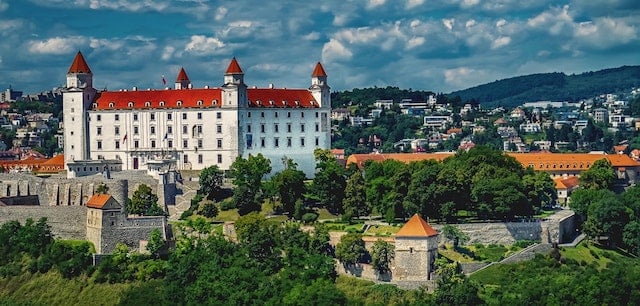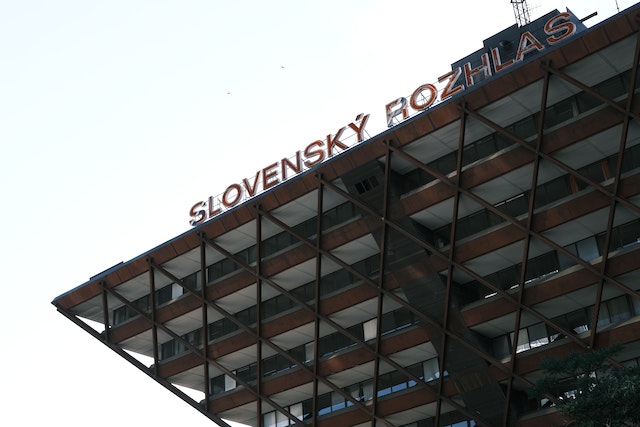What Language Do Slovaks Speak? 8 Answers About the Slovak Language
Slovakia is a fascinating country, but whenever it comes up in one of our article blogs, readers seem to have lots of questions about it. If you’ve ever wondered “What language do Slovaks speak?” or whether Slovak and Slovenian are similar to one another, you’ve come to the right place.
In this article, we’ll explore eight interesting facts about the Slovak language, including its origins, differences from Slovenian, and tips for learning the language.
→Sign Up Now: Free Trial Slovak Lesson With a Native Teacher!←
What Language do Slovaks Speak?
Table of Contents
1. What Is the History of the Slovak Language?
Origins
The Middle Ages
Towards a standardized version of Slovak
The 20th Century
Slovak today
2. What language do Slovaks speak?
3. Is Slovak a language or a dialect?
4. What countries speak Slovak?
5. Slovak and Slovenian: Different or similar?
Similarities
Differences
6. Slovakia: Languages spoken
7. What alphabet is used for Slovak?
Diacritic marks
Unique sounds
8. What’s the best way to learn Slovak?
Immersion
Language exchange
Language apps
1. What Is the History of the Slovak Language?
Origins
The Slovak language is a member of the Slavic language family and is closely related to other Slavic languages such as Czech, Polish, and Ukrainian. The origins of the Slovak language date back to the Slavic tribes that settled in the region of present-day Slovakia in the 6th and 7th centuries.
The Middle Ages
During the Middle Ages, the Slovak language began to develop its own distinct characteristics, influenced by the neighboring Czech and Hungarian languages. In the 14th and 15th centuries, the Slovak language began to emerge as a literary language, with the first written works in Slovak appearing during this time. These early works were written in a form of Old Slovak, which was heavily influenced by Latin and Church Slavonic.
In the 16th and 17th centuries, the Slovak language underwent significant changes, as a result of increased contact with other European languages and the influence of the Reformation and Counter-Reformation movements. The language became more standardized, with the development of a standardized grammar and spelling system.
Towards a standardized version of Slovak
In the 19th century, Slovak nationalism began to emerge. In this contect, the government started to make efforts to promote the Slovak language and culture. This led to the development of a literary form of Slovak. This form was based on the central Slovak dialect, which became the standard form of the language. The first Slovak grammar, published in 1843 and the first Slovak-language newspaper in 1944. Both publications helped consolidate the status of the Slovak language.
The 20th Century
After World War I, Slovak became an official language alongside Czech. However, during World War II, Slovakia was briefly independent. During this time, the Slovak language was the official language of the Slovak Republic. After World War II, with the re-establishment of Czechoslovakia, Slovak remained an official language of the country.
Slovak today
In 1993, Slovakia declared independence from Czechoslovakia, and Slovak became the official language of the new country. Since then, efforts have been made to promote the use and preservation of the Slovak language. Measures included the establishment of language schools and the development of language policies and standards. Today, Slovak is an important part of the cultural identity of Slovakia. All around the country, efforts continue to ensure its continued use and development.

Image by Pixabay, via Pexels
2. What language do Slovaks speak?
Slovaks speak Slovak, a West Slavic language. In present-day Slovakia, Slovak is in use by almost the entire population (78.6%), except for a few minority groups. This means that at least 5 million people use Slovak only in Slovakia.
3. Is Slovak a language or a dialect?
Before answering this question, we need to understand the differences between a language and a dialect. A language is typically used to refer to any complex linguistic system which has its own unique set of rules. A dialect, on the other hand, is a variation of the language but has not developed into an entirely independent system.
With this in mind, we can assert that Slovak is a distinct language and not a dialect. This means that the initial question, at least, was correct. We should ask “What language do Slovaks speak?”, and not what dialect they speak.
While Slovak shares similarities with other Slavic languages such as Czech and Polish, it has its own unique grammar, vocabulary, and pronunciation.
In other words, it has enough distinct features to be considered its own language.
4. What countries speak Slovak?
After “What language do Slovaks speak?”, this is the question we get asked most often!
What countries speak Slovak apart from Slovakia?
The largest Slovak-speaking community outside of Slovakia is in the Czech Republic, where approximately 200,000 people speak Slovak as their first language. There are also significant Slovak-speaking communities in the United States, Canada, and Australia, where many Slovaks have emigrated over the years.
In the United States alone, it is estimated that there are over 500,000 people of Slovak descent. Many –but not all– of them still speak the language.

Image by Leopold Biget, via Pexels
In addition to these countries, there are smaller communities of Slovak speakers in other parts of Europe, such as Hungary, Serbia, Croatia, and Romania.
Last but not least, there are also smaller communities of Slovak speakers in countries like Argentina, Brazil, and Chile, where Slovaks have immigrated over the years. So, no matter where you are, you should be able to find Slovak speakers!
5. Slovak and Slovenian: Different or similar?
Slovak and Slovenian are two Slavic languages that are often confused due to their similar names. However, while they share some similarities, they are distinct languages that present both similarities and differences.
Similarities
- Both Slovak and Slovenian belong to the Slavic language family. They’re part of the West Slavic and South Slavic branches, respectively.
- The two languages use the Latin alphabet with diacritic marks to indicate specific sounds.
- Both languages have a rich case system, with multiple cases. These are used to indicate the grammatical role of nouns, adjectives, and pronouns.
Differences
- Phonetically, Slovak and Slovenian differ significantly. Slovak has a complex system of consonants, including voiced and unvoiced sounds. Slovenian has a simpler system with fewer consonants.
- The grammar of Slovak and Slovenian also differs in many ways. For example, while both languages have a rich case system, the cases used and their meanings are different. Additionally, Slovenian has a dual number in addition to singular and plural, whereas Slovak only has singular and plural.
- Vocabulary-wise, there are also differences between the two languages. Many words in Slovak have Germanic or Hungarian roots, whereas Slovenian has more words with Slavic roots. Furthermore, while both languages have borrowed words from other languages over the years, the words borrowed and their origins are different.
6. Slovakia: Languages spoken
Slovak is the official language of Slovakia and is spoken by the majority of the population, approximately 5 million people. However, there are also significant linguistic minorities in the country, including Hungarian, Czech, Romani, Ukrainian, and German.
Hungarian is the most widely spoken minority language, with around 500,000 speakers, predominantly living in the southern regions of Slovakia, along the Hungarian border. Czech is also a common minority language, spoken by around 70,000 people. They liv mainly in the northern regions of the country, near the Czech border.
The Romani language is spoken by around 30,000 to 40,000 people, mostly in the eastern part of the country. Ukrainian and German are also popular among smaller linguistic minorities, with around 10,000 speakers of each language.
In addition to these minority languages, there are also other languages in use among smaller communities in Slovakia, such as Polish, Russian, Bulgarian, and Serbian.
Overall, the linguistic landscape of Slovakia is diverse, reflecting the country’s multicultural heritage and its historical ties to neighboring countries. All of this contributes to Slovakia’s linguistic and cultural richness.
7. What alphabet is used for Slovak?
The Slovak alphabet consists of 46 letters, including all 26 letters of the basic Latin alphabet and 20 additional letters with diacritic marks.
Diacritic marks
The frequent use of these diacritic marks is one of the most distinguishing features of written Slovak. Mainly, they indicate different vowel sounds. For example, the letter “a” with a diacritic mark above it (á) has a more prolonged sound than the “a” without a mark.
The same is true for the letters “e”, “i”, “o”, “u”, and “y”, which can take diacritic marks to show different variations.
Unique sounds
The Slovak alphabet also includes some letters not present in the basic Latin alphabet. For example, there are several characters such as “ä”, “ô”, “ŕ”, and “ľ”, which represent unique sounds in the Slovak language. In addition, there are several digraphs, such as “ch”, “dz”, and “dž”, which represent combinations of sounds not often found in English.
8. What’s the best way to learn Slovak?
Learning a new language can be challenging, but there are several effective ways to learn Slovak. Here are some tips:
Immersion
Immersing yourself in the language and culture is one of the most effective ways to learn Slovak. This can involve traveling to Slovakia, watching Slovak TV shows and movies, listening to Slovak music, and speaking with native speakers. By doing this, you become familiar with the language and its pronunciation much faster.

Image by Andrea Piaqcuadio, via Pexels
Language exchange
Finding a language exchange partner or conversation group can be a fun way to practice speaking Slovak. Websites like iTalki and Tandem can help you find language exchange partners. Having someone to practice speaking with can help keep you motivated and make learning more enjoyable.
Language apps
Language learning apps like Duolingo, Babbel, and Rosetta Stone offer interactive and engaging lessons that can help you build your vocabulary and grammar skills. The game-like nature of these apps can help make learning Slovak fun and accessible.
Tailor-Made Slovak courses
Taking a structured language course is the best way to get a solid foundation for learning Slovak. Interacting with a native teacher in a classroom or online is the best way to:
- Get expert feedback
- Practice speaking and listening
- Develop confidence in your language skills
- Get language-training for a specific purpose
→Sign Up Now: Free Trial Slovak Lesson With a Native Teacher!←
At Listen & Learn, we offer group and private language lessons specifically designed to help every student achieve their learning goals.
So, would you like to go beyond simple questions like “What language do Slovaks speak?” and learn to speak Slovak yourself?
Contact us now and take the first step towards fluency. You won’t believe how quickly will start using Slovak in conversation!


